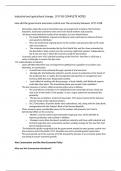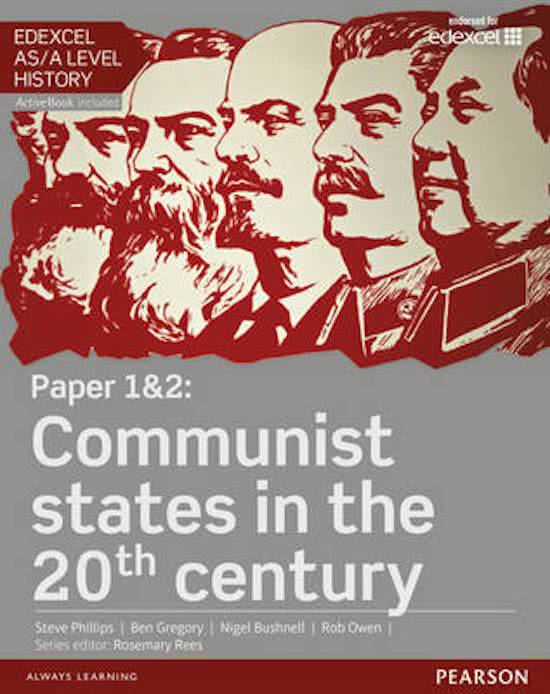Industrial and agricultural change, 1917-85 COMPLETE NOTES
How did the government excessive control over the economy between 1917-1928
- Declaration stated by Lenin in November gave encouragement to believe that factories,
industries, businesses and farms were now in the hands workers and peasants.
- Yet these words belied the reality of the situation, as Lenin himself knew.
o The equal distribution of goods according to need could only be achieved if there
were goods to distribute.
o Thus, the excitement of giving power to the workers and peasants did not fit easily
with circumstances.
o The economy was devastated by the First World War and the chaos unleashed by
the Revolution. State control over the economy might limit workers' independence,
but it was one way in which the economy could be rejuvenated.
- Economic policy from 1917 until the launching of the First Five- Year Plan in 1928 was a
series of attempts to resolve this key issue.
The nationalisation of industry
- Lenin admitted that there was no blueprint for getting from capitalism to socialism and,
ultimately, to communism.
o It would have to be achieved through a period of trial and error.
o Ideologically, the Bolsheviks wished to see the means of production in the hands of
the proletariat but, in reality, the bourgeoisie had expertise in management and
technical skills that were desperately needed.
o Lenin talked of working with these groups, at least initially, until Bolshevik experts
could take their place. This transitional phase was termed 'state capitalism'.
- The key measures of Lenin's initial economic policy were as follows:
o The Land Decree of October 1917 abolished private ownership of land, which was
now to be in the hands of 'the people.’ It was a vague statement but pleased the
peasantry
o The Decree on Workers' Control of November 1917 placed control of the factories
into the hands of the industrial workers.
o On 27 December, all private banks were nationalised, and, along with the State Bank,
amalgamated into the People's Bank of the Russian Republic.
- These measures gave considerable power to the workers and peasants, but it had a
detrimental effect on the economy.
o Workers' councils voted to give themselves huge pay rises, which did little to
improve production and resulted in inflation.
o Managers were often dismissed, sometimes violently, and those with industrial and
technical expertise were removed by workers seeking revenge for the way they had
been treated previously.
- The Bolsheviks quickly recognised that the government needed to exert greater control over
the economy and in December 1917, Vesenkha was set to provide greater supervision
- This early period, up to the summer of 1918, showed the stresses of an economic policy that
was trying to ensure economic growth.
War Communism and the New Economic Policy
Why was War Communism introduced?
, - Faced with the desperate circumstances of the civil war, the Bolsheviks introduced a series
of measures to ensure that the Red Army was supplied with enough food and resources to
emerge victorious.
- These measures entailed much greater government intervention in the economy and
collectively became known as War Communism.
The ideological basis:
- WC went along with the long-term aim of the Bolsheviks to abolish private enterprise and
could be seen as the application of communist ideology
- To some Bolsheviks, the old world had been destroyed by the First World War and this
provided an opportunity to build anew on Marxist lines.
- The result of this optimism was a radicalisation of policy, pushing the Bolshevik leadership
into implementing large-scale nationalisation before it had originally intended to.
- The nationalisation of all industries with ten or more workers in June 1918 was followed by a
series of measures that showed the Bolsheviks were keen to extend government control
The response to the reality of economic collapse:
- There were also practical reasons for introducing WC.
- The Bolsheviks had inherited an economy that was in a state of near collapse and drastic
measures were needed if they were to fight and win the civil war.
- State direction of the economy had been a key feature of many European countries during
the First World War and it had little to do with ideology.
A reaction to early Bolshevik excesses:
- In some aspects WC was a response to the problems that resulted from the rush of early
Bolshevik decrees.
- Some of the Bolshevik policies for giving control to the workers proved to be idealistic and
unworkable, especially during a civil war
- The abolition of army ranks was reversed, and factory managers had to be used to create
some order in industry.
What were the key features of War Communism?
The main features were as follows.
o Nationalisation of all industry; only workplaces with fewer than ten workers were exempt.
o All industry was placed under the control of the Vesenkha, set up in 1917.
o In factories, the Workers' Councils were replaced by management in order to instil discipline
into the workers.
o Harsh military-style discipline was introduced into the factories. The death penalty was
introduced for all workers who went on strike.
o All private trading was banned. Trade was to be controlled by the state
o Transactions using money became limited due to massive inflation; replaced by bartering
o The forcible requisitioning of food from the peasants in order to feed the army and the
towns.
o Around 150,000 Bolshevik volunteers were used to seize grain. Malnutrition and
starvation became commonplace.
o The introduction of rationing to ensure that, despite food shortages, the workers in the cities
were fed. Those industrial workers whose work was crucial to the war effort received
preferential treatment.
War Communism ensured that the Red Army got the resources it needed to fight and win the civil
war, but it left the economy in a state of collapse. By 1921, industrial production was only one-fifth
of the figure for 1913. Disease and starvation were common and a wave of serious unrest swept
across the countryside.





